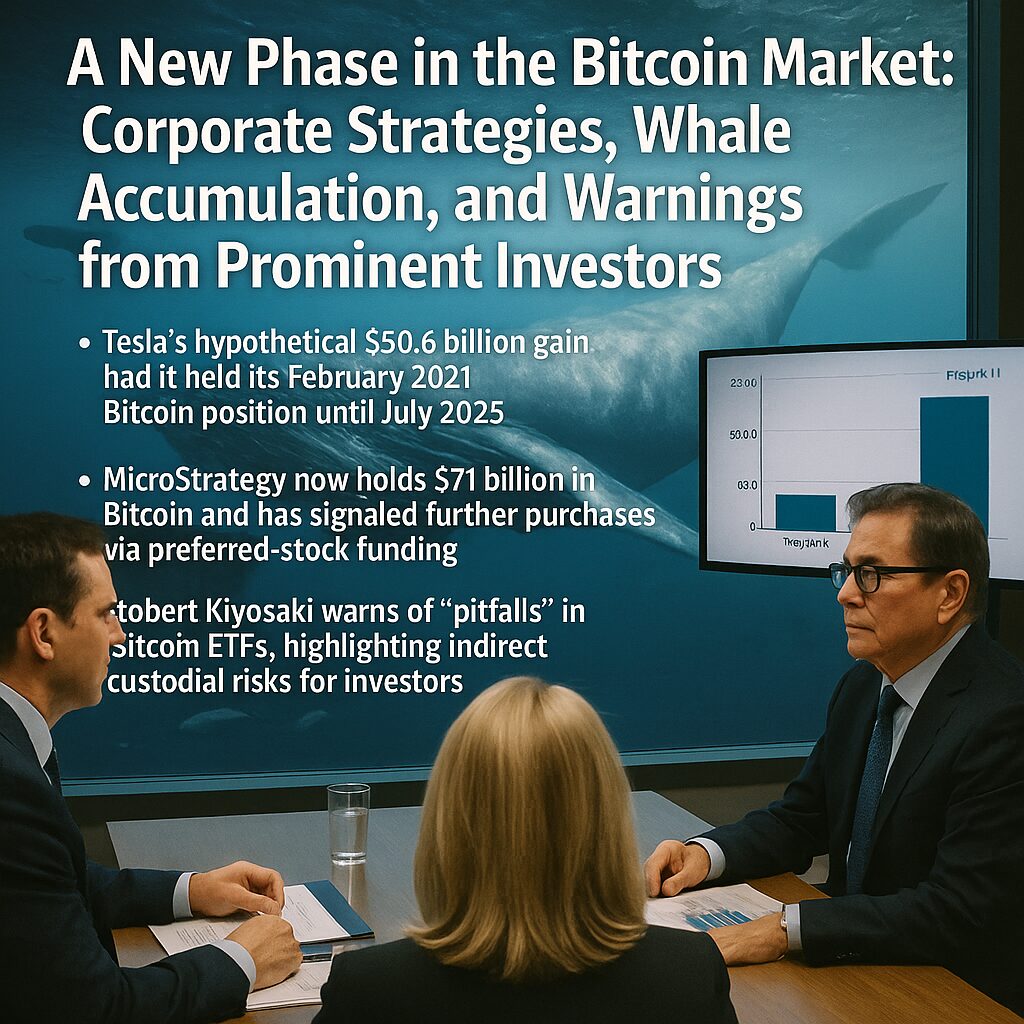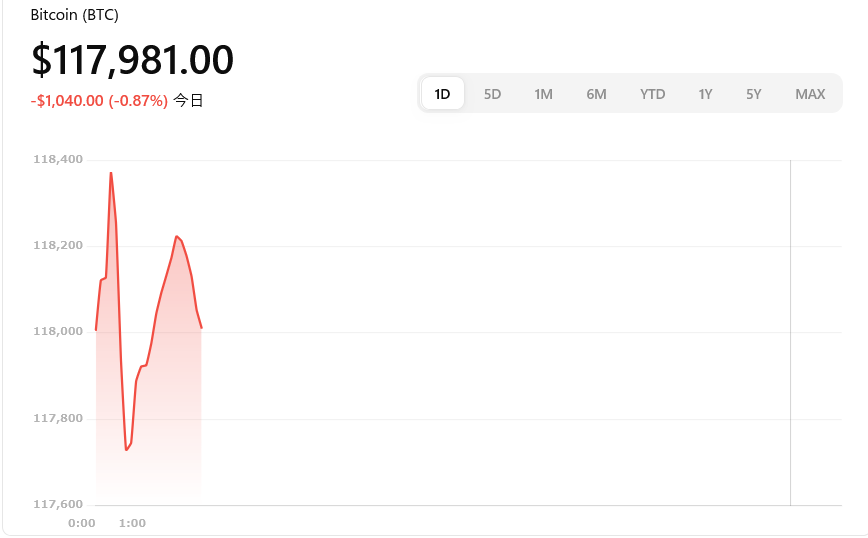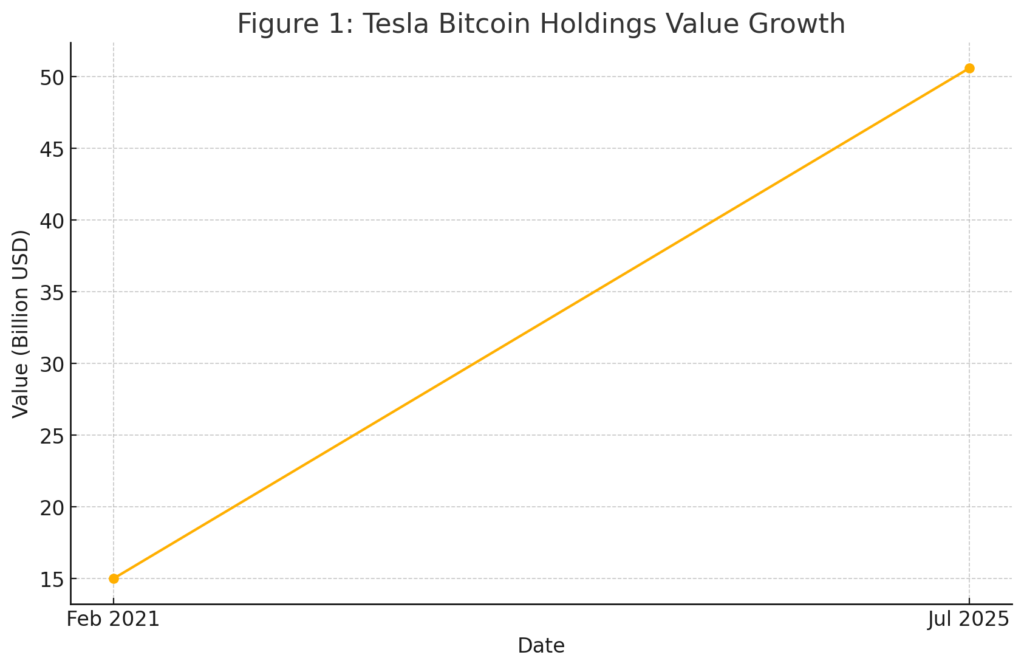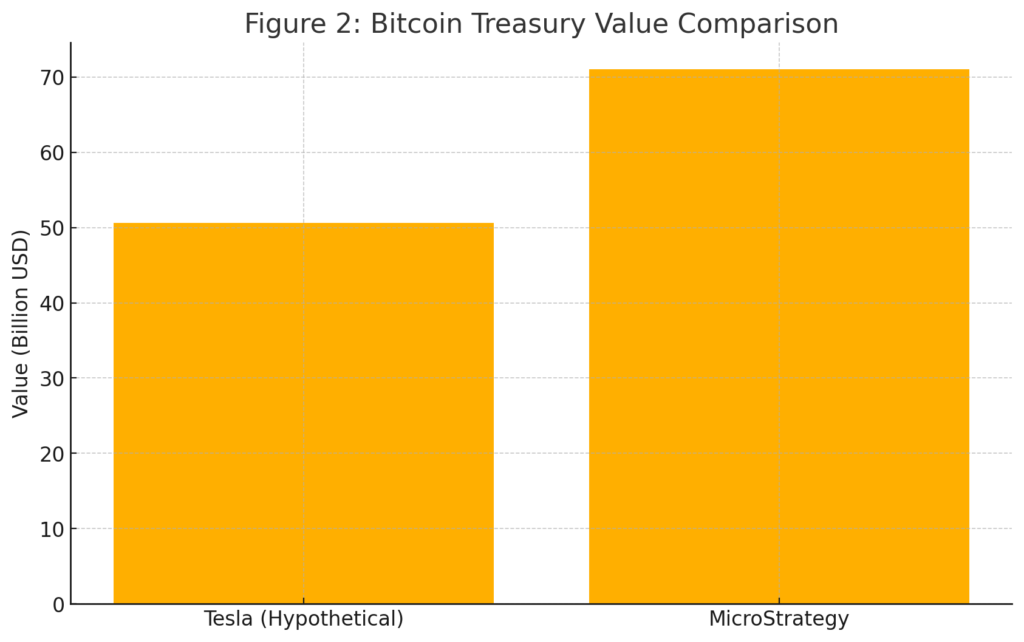
Main Points:
- Tesla’s hypothetical $50.6 billion gain had it held its February 2021 Bitcoin position until July 2025 (Figure 1)
- MicroStrategy now holds $71 billion in Bitcoin and has signaled further purchases via preferred-stock funding
- Robert Kiyosaki warns of “pitfalls” in Bitcoin ETFs, highlighting indirect custodial risks for investors
1. Tesla’s Bitcoin Sell-Off: Regret or Strategic Move?
In February 2021, Tesla announced a $1.5 billion Bitcoin purchase at an average price of roughly $36,000 per coin, positioning the company as a pioneer among corporate crypto treasuries. However, by April 2021 it sold 4,320 BTC for a $272 million profit, citing liquidity needs and environmental considerations. If Tesla had retained its full position, its Bitcoin holdings would be worth approximately $50.6 billion as of July 2025—more than a threefold increase (Figure 1)

Tesla’s decision underscores the delicate balance between capturing long‑term upside and managing market‑volatility risks on the corporate balance sheet. While the sale locked in short‑term gains that boosted Q1 2021 earnings, it also meant forgoing tens of billions in unrealized appreciation.
[Insert Figure 1 here: Value Growth of Tesla’s Bitcoin Holdings from Q1 2021 to July 2025]

2. MicroStrategy’s Aggressive Accumulation Strategy
Under Michael Saylor’s leadership, MicroStrategy has doubled down on Bitcoin as its primary corporate asset. As of July 2025, the company holds 608,000 BTC, valued at about $71 billion, after recently raising $2.5 billion via preferred‑stock issuance to fund further purchases.
This “crypto‑treasury” approach transforms Bitcoin from a speculative gamble into a core element of enterprise strategy. By layering equity and debt instruments—preferred shares like STRC alongside convertible bonds—MicroStrategy aims to secure permanent capital for ongoing accumulation while offering investors yield exposure linked to Bitcoin’s performance. Such structuring, however, elevates liquidity‑and‑solvency considerations: should Bitcoin’s price sharply correct, the company’s layered obligations could strain its balance sheet.
[Insert Figure 2 here: Comparison of Bitcoin Treasury Values: Tesla vs MicroStrategy]

3. Robert Kiyosaki’s Warning: The “Pitfalls” of Bitcoin ETFs
Robert Kiyosaki, the author of Rich Dad Poor Dad, has cautioned investors about the indirect nature of Bitcoin ETFs. While ETFs offer streamlined access via traditional brokerage accounts and eliminate self‑custody concerns, they carry unique counterparty and regulatory risks. Kiyosaki argues that ETF investors do not hold “true” Bitcoin; instead, they hold shares in fund‑managing entities that may face insolvency or regulatory intervention, potentially leading to asset‑tracking discrepancies.
For Japanese and international investors weighing Bitcoin ETFs, the key takeaway is to evaluate convenience against the core principle of DeFi: direct, self‑sovereign asset ownership.
4. Recent Market Trends and Outlook
Beyond Tesla and MicroStrategy, a growing cohort of publicly traded companies—98 since June 2025—have announced crypto‑purchase programs totaling over $86 billion. Institutional interest now spans legacy financial firms, technology conglomerates, and specialized funds, driving Bitcoin liquidity dynamics and price formation. Meanwhile, regulatory clarity on ETF frameworks in the U.S. and Europe, alongside innovations in on‑chain custodial services, continues to shape investor access pathways.
Looking ahead, the interplay between corporate treasuries, retail‑oriented ETFs, and self‑custody solutions will determine whether Bitcoin evolves into a mainstream treasury asset or remains primarily a speculative instrument. Risk management—hedging strategies, duration controls, and governance frameworks—will be paramount for organizations integrating Bitcoin alongside traditional reserves.
Conclusion
The recent corporate maneuvers by Tesla and MicroStrategy, coupled with cautionary advice from influencers like Robert Kiyosaki, mark a pivotal shift in how Bitcoin is perceived and deployed on institutional balance sheets. As more companies race to accumulate Bitcoin and ETFs proliferate, investors must navigate the trade‑offs between direct ownership and convenient exposure. Ultimately, the maturation of risk‑management practices and regulatory frameworks will decide whether Bitcoin solidifies its role as a strategic asset class or remains vulnerable to the vicissitudes of market sentiment.

